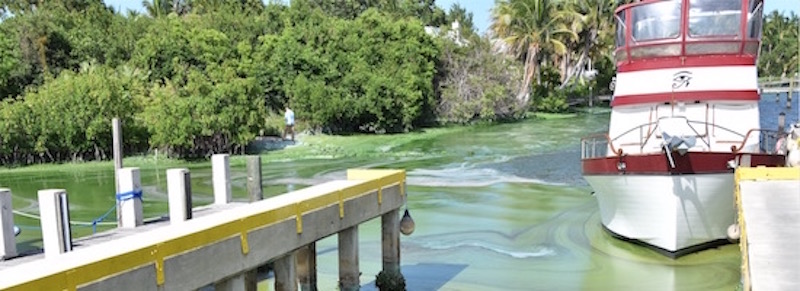GUEST POST: Fixing the Monster of Our Own Making
GUEST POST: Fixing the Monster of Our Own Making
Outdated priorities and a broken operational system have left Florida in a tailspin of escalating catastrophes. Recently, a sharper look at the downstream effects of massive Lake Okeechobee discharges impacting health and human safety has taken center stage as more and more research surfaces tying exposure to algal toxins to a myriad of devastating health impacts.

Introducing federal legislation, like that filed by Congressman Brian Mast last week, requiring our government to manage Lake Okeechobee in a way that doesn’t poison people is one way to reverse this toxic tide, right now.
Another way is suing the federal agencies responsible for failing to address the harms caused by the current outdated schedule for discharging lake water into the rivers. The Center for Biological Diversity, with the Calusa Waterkeeper and the Waterkeeper Alliance has done just that, underscoring the fact that we don’t have decades to wait–the time for action is now.
(Original work written by Jaclyn Lopez, Center for Biological Diversity. Published on 6/18/2019 by the Orlando Sentinel, available online here.)
Return of Florida’s toxic algae season signals need for bolder solutions | By Jaclyn Lopez, Center for Biological Diversity
Like a summer rerun of “The Return of Swamp Thing,” Floridians re-awakened in recent days to our own annual horror show: The return of highly toxic blue-green algae.
But unlike some imaginary creature rising from the Everglades, the putrid, wildlife-killing sludge that produces toxins now linked to liver disease and everything from Alzheimer’s to ALS and Parkinson’s is a very real monster of our own making.
We know a lot about the things that play an outsized role in triggering our recurring toxic nightmare.
We know the diked waters of the once-free-flowing Lake Okeechobee provide an unnatural breeding ground for blue-green algae to feed on our own pollution, including waste from leaky septic tanks and run-off of nitrogen and phosphate agricultural fertilizers.
And we know the toxic sludge that’s then released from the lake into the Caloosahatchee and St. Lucie rivers eventually makes its way to our coastal waters, where, researchers believe, it helps to fuel the toxic red tides that endanger public health, kill fish, protected sea turtles and manatees and choke our coastal economies.
Yet, here at the dawn of what’s likely to be another toxic algae season, we have failed to take any meaningful steps to reduce the escalating point-source pollution from those septic tanks and agricultural fertilizers.
And along with the failure of Florida’s leaders to address the problem, decades of federal foot-dragging has allowed the problem to fester and worsen.
For more than 10 years, federal agencies have put off important upgrades to the lake’s ancient Herbert Hoover dike and ignored the legal requirement for assessing and mitigating harm to endangered species caused by the lake’s annual toxic releases.
That’s why the Center for Biological Diversity, where I work as Florida director, joined with Calusa Waterkeeper and Waterkeeper Alliance last week to sue the U.S. Army Corps of Engineers for failing to address the harms caused by the current outdated schedule for discharging lake water into the rivers.
But beyond taking the legally required steps to clean up the water we dump into, then discharge out of, the lake, we have no choice to but take much bigger steps if we really hope to reverse this rising toxic tide.
A plan that pushed hard in that direction came together back in 2008 when then-Gov. Charlie Crist signed off on a plan for the state to purchase 187,000 acres of U.S. Sugar land that would have re-opened a natural flow-way between the lake and the Everglades.
But over the last decade, leaders both here in Florida and Washington, D.C., have turned their backs on that plan.
Instead, they’re now celebrating a dramatically scaled back plan to build a 10,000-acre above-ground reservoir that represents the exact kind of incremental, ineffective steps that have left us treading toxic waters every summer.
The 23-foot-deep reservoir not only represents a mere drop in the bucket relative to the size of the problem, it will actually destroy some of the area’s limited habitat for wildlife.
It’s like trying to save a person from drowning in a 15-foot-deep pool by draining off a foot of water. It might make you feel a little better about your effort but it’s not going to save the drowning victim.
Gov. DeSantis has offered a glimmer of hope last week by convening the first meeting of his task force to study the state’s toxic algae problem. And perhaps under his leadership we can actually chart a path forward to clean up our mess.
But it will require not only following the common-sense steps established by law to protect our water quality and all life that depends on it, but having the guts to take huge leaps in how we manage the lake’s discharges and the health of the Everglades and our rivers.
We can only hope the governor understands that it’ll take a lot bigger commitment than building what amounts to little more than an expensive swimming pool to hold the toxic sludge we continue to pump into Lake Okeechobee.
St. Petersburg resident Jaclyn Lopez is Florida director of the Center for Biological Diversity.


